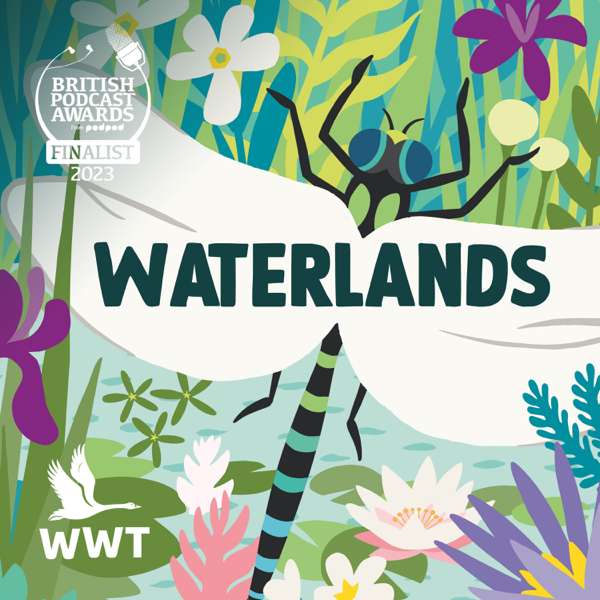Alix explores how citizens of the Eastern Band of the Cherokee Indians are renewing connections to their traditional homelands in the park, with the help of a certain plant species.
Featuring: Tommy Cabe and Joshua Albritton.
For more info, visit: go.nps.gov/smokysignal
---
TRANSCRIPT:
---
[OPENING SCENE: ALIX SEARCHES FOR SOCHAN]
Alix: It’s springtime here in Great Smoky Mountains National Park, and I’m walking down a wide, flat river trail. The river is to my left, and it’s clear and calm. I’ve only walked a few minutes before I find what I’m looking for: it’s in a flat, sunny patch of woods between me and the river: a tightly packed cluster of light green leaves.
I kneel down to be sure, to examine the shape of one of the soft leaves. I find the tell-tale ‘turkey foot’ or three lobed leaf that confirms my ID. When I look back up, I realize I’ve found an entire patch of it: sochan, or green-headed coneflower.
I close my eyes, and picture spending the morning here, hand-picking enough young leaves to boil and cook up in a cast iron skillet seasoned with bacon, the way many greens are cooked traditionally in this region. I imagine the nourishing taste of the warm, earthy greens. I picture how the ancestral knowledge of how to find, harvest, prepare and cook sochan has been passed down for generations through oral tradition.
Today, we’re going to be digging into a story about the relationship between people, land, and this particular plant called sochan—and how that relationship has been sustained for millennia.
[INTRODUCTION WITH ALIX AND ANTOINE]
Antoine: Right, because Great Smoky Mountains National Park has only been around since 1934, but this area has long been, and remains, the traditional homelands of the Indigenous Cherokee people.
Alix: That’s right. The Eastern Band of the Cherokee Indians is one of over 600 federally and state recognized tribes throughout the US. Citizens of the tribe are descendants of a small group of Cherokee individuals who remained here, despite forced removal by the US government during the 1830s-era Trail of Tears. The Cherokees’ ancestral homelands span eight states in the southeastern US, including what we now call Great Smoky Mountains National Park. For millennia, Cherokee people have hunted, fished, gathered, and stewarded the land here. Their knowledge and connections to the land run deep.
Antoine: Today, members of the Eastern Band of the Cherokee Indians reside in the Qualla Boundary—a tribal land trust in and around Cherokee, North Carolina. The Qualla Boundary borders the park to the southeast.
Alix: In today’s episode, we’re exploring how some Cherokee people are staying connected to their homelands in the Smokies—with the help of sochan. Whether you’re listening here in the park or from home, we hope this story about peoples’ connection to this land—past and present—can help you better appreciate and understand that land—wherever you are.
Welcome to Smoky Signal, a show about the science behind the Smokies. Brought to you by Great Smoky Mountains National Park and produced on the traditional lands of the Cherokee.
Antoine: This season, we’ll be exploring three stories on the theme of Collections. We’ll be talking about renewing traditional plant gathering practices, a natural history museum that has collected thousands of species, and, even the collection of something pretty stinky in the name of science.
Alix: I’m Alix.
Antoine: I’m Antoine. Stay with us.
[PART ONE: SOCHAN GATHERING, PAST AND PRESENT, WITH TOMMY CABE]
Alix: One crisp day last fall, Tommy Cabe drove up and over Newfound Gap Road to meet me at Twin Creeks Science Center. Tommy is a Forest Resource Specialist for the Eastern Band of the Cherokee Indians and a citizen of the tribe.
I was there to learn more about sochan, a plant Tommy has thought a lot about lately. A member of the sunflower family, sochan is a tall, yellow-flowered herbaceous plant that grows throughout the park in sunny, wet areas and along stream banks.
Tommy: [speaking Cherokee]--Tommy Cabe--[speaking Cherokee]. I said, 'Hello, my name is Tommy Cabe, and I am from Birdtown community.
Tommy: The first time I was taken to the sochan patch, I was probably about anywhere from five to seven years old.
And so would go down below my grandmother's house along the creek bank. And at that time of the year, sochan starts to come out in these little clusters. That's when my family would like to pick it the most.
Alix: Tommy spent those early spring mornings gathering the young, tender leaves of sochan by the creek with his extended family -- aunts, uncles, parents, grandparents. He remembers peering over the creek’s edge, watching schools of little red and blue fish swim by, and peeking between river rocks and cobbles for Yunwi Tsunsdi—the ‘little people’ he’d heard about in Cherokee legends.
Tommy describes this time of year—with winter coming to an end and the earth waking up—as ‘magical’. For him, collecting, cooking and eating sochan—that first spring green—was a treat; something to re-awaken the mind and body.
Today, Tommy still collects sochan each spring. But now, he brings his own children with him.
He teaches them how to pick the last three lobes of each leaf—the ‘turkeyfoot’—off young sochan shoots and demonstrates how to say a prayer thanking the Creator, his ancestors, and the plant, before picking the first leaf. He also reminds his kids to never harvest from the first sochan plant they find, because, he says, “you never know what kind of day it’s going to be.”
Tommy: Yeah, it's important because it's generational knowledge, right. And, of course, I want to continue the cycle of passing that knowledge on whether, you know, my kids actually pick it up and run with it, or they don't. But every time I go out, they do get curious and want to tag along. And so, I try to teach them as best I can, in this world of screens and technology to where it makes sense. And it's important for them to know that they're Cherokee, that they're a part of this ecosystem for millennia. And that, what they do, and what they learn—how they apply what they learn—matters to us as having this relationship with the ecosystem, and these mountains. Page Break
Alix: Great Smoky Mountains National Park allows limited collection of nuts, berries, and certain mushrooms for personal consumption. But until recently, federal law has prohibited Cherokee people from collecting sochan and many other culturally significant plants within the boundaries of the park.
In 2016, new National Park Service regulations established a framework for federally recognized tribes to gather certain plants or plant parts within national park units for food, ceremonial, medicinal, and cultural purposes. This rule paved the way for Indigenous people to renew cultural practices and connections to their homelands.
At the time, Tommy was several years into a collaboration with the US Forest Service and the North Carolina Arboretum to study the sustainability of sochan harvest in the region. Data available from these studies, combined with sochan’s cultural significance, meant it was the logical plant to focus on first.
In 2019, after an Environmental Assessment, public comment period, and Finding of No Significant Impact, tribal and park leaders entered into a historic agreement enabling Cherokee people to once again gather sochan in the park.
[PART THREE: SOCHAN MONITORING WITH JOSHUA ALBRITTON]
Alix: Joshua Albritton is a Biological Science Technician in the park and has been involved with the sochan gathering program from its beginnings. He told me about the permitting and monitoring processes outlined in the Environmental Assessment that aim to ensure the program is sustainable.
Joshua: So each season, there are 36 harvest permits issued. And in order to get one of those permits, first of all, the person has to be a member of the EBCI—the Eastern Band of Cherokee Indians. And then, every season or every year from sometime between January and March, we hold several joint workshops between the EBCI leadership and us in the Smokies.
Alix: Each gatherer attends one of these workshops, where they learn about the program’s specific guidelines, which were informed by gatherers’ preferences in harvesting. Each year, harvest season runs from March first to May thirty-first, when sochan leaves are still new and tender. Using traditional hand-picking methods, gatherers can collect up to a bushel of sochan—enough to fill about two cloth grocery bags—each week.
Some Cherokee families traditionally collect just the ‘turkeyfoot’ (the final three lobes of a leaf) while others like to collect the entire leaf—and gatherers can collect whichever part they prefer. Because sochan gathering is traditionally a communal, family practice, each permitted gatherer can bring up to five additional gatherers with them each time they harvest.
The program has grown since it began in 2019—when only 10 of the 36 permits were filled. This past year, in 2021, all 36 were filled.
Joshua told me that, each time a gatherer comes to the park to collect sochan, they submit a harvest report to him. He uses these reports and additional monitoring to assess any impacts of sochan gathering through time.
Joshua: So in the springtime, we ask for the harvest reports. And I go out behind each report, I locate the spot where the person or group harvested...
What we're looking for is location, we're looking for, how much did you harvest? How many people came out with you? How long did you spend in the field, and are you going to come back to the same spot again?
Alix: Joshua returns to these areas again in late summer, to collect additional information when sochan is flowering.
I went out with him to one of these sites—a flat, open area near a flowing, rocky creek, to learn more about this phase of monitoring.
Joshua: So, back in the spring, in April, we got a couple of reports from this site from harvesters. So we know this site was harvested before this year, possibly the year before as well. We came out. Based on that report, we came out we check the site, we did see where they harvested, we checked a few of the plants then just to make sure that everything was it was within the specifications. And the usage permit it was, which is excellent. Now, we've come back out in the summer to look at: are there any changes to the community or to the sochan plants themselves, based on this kind of harvest history of this site?
Alix: Joshua lays out a sampling area using forestry tapes and square-meter PVC plots. Then he marks each plant with a stake flag, assesses how many stems it has, how tall they are, and how many of them are flowering. He'll return to this site in subsequent years to collect similar data and to see if anything is changing through time.
Joshua: Through time we're looking at, are there any possible stressors? And are they affecting the plants, in terms of, is the abundance going down? Is the average height going down? Are they not flowering as often? Or conversely, maybe harvesting has a positive effect. Maybe stem abundance is going up, maybe height is increasing slightly, maybe flowering is greater—maybe they're producing more flowers.
Alix: In addition to monitoring the areas where gatherers have been, Joshua also collects data from two other areas: ‘control’ sites and ‘research harvest’ sites. The control sites are so-called ‘off-limit’ areas, where no sochan gathering occurs. By comparing the harvested sites to these control sites, Joshua can tease apart any potential impacts of harvesting relative to other ‘normal’ variations in sochan growth or flowering through time.
Next to each control site, Joshua and Tommy also established a ‘research harvest’ site. Each spring, Tommy returns to these sites to harvest sochan following traditional methods. He ends up collecting a lot of sochan during the process and shares it with his Community Club, his mother, and with other families that can't gather sochan themselves.
Joshua: And so [Tommy] comes in and he harvests; we know exactly where he harvests and how much he harvests. Then we go in behind him and do all the monitoring. So we can, in these specific spots, we can actually look at, okay, this is how much he's harvested. And then in turn, we collect our summer data. And we can see, what are the impacts of those harvests? And we know that nobody else has been there.
Alix: After each season of monitoring, Joshua analyses the data to look at any potential impacts of harvesting—negative or positive.
Joshua: The latter example is what we're seeing in the numbers through time. Just a little bit at some of the harvest sites here in year three—we're seeing a slight increase in abundance, a slight increase in flowering. So harvesting may actually benefit these communities.
Alix: Joshua’s findings confirm what Cherokee sochan gatherers have long understood: just as grass grows back thicker after being mowed, harvesting sochan leaves seems to stimulate new growth. Cherokee gatherers understand that harvesting a sochan plant can help ensure that it will be healthy and lush when they return again next spring to harvest.
Joshua: What we’ve seen so far is, there have been no negative impacts from harvesting on plant communities thus far that we can see in the data that we've collected. So, at least from my perspective, we're really in good shape to continue with the program moving forward.
[PART FOUR: THINKING BIG PICTURE]
Alix: Tommy told me about an initiative in his community called Cherokee Choices that promotes culturally significant, healthy lifestyles. Part of that initiative is to bring traditional Cherokee foods to the forefront of modern meals.
Tommy: And, so thinking about what that plate looks like, you’ve got for instance, sochan and ramps. And you probably had the three sisters, which are corn, beans and squash. From the landscape, you probably had some type of fish or wild game, and you had mushrooms, right.
How you would prepare a Cherokee traditional meal would be 90% of it coming from the landscape, if not all of it.
Alix: Sochan leaves, which are rich in vitamin A and minerals like iron, calcium, and potassium, rival the nutritional potency of other so-called superfoods like kale and spinach. Tommy hopes that this gathering program will get sochan, and other healthy, wild-harvested foods, showing up more often on the plates of Cherokee people today.
Some gatherers have expressed frustration with Tommy over the program’s cumbersome permitting and reporting process. And he says he can relate to their frustration sometimes when he’s navigating government paperwork and policy. But he said that, overall, he’s heard mostly positive feedback.
Tommy: We're living in an age where we have access, and our relationship with these plants and this ecology is starting to matter. And what matters is that we we're still here, and we still live off this landscape. And this is a part of our landscape that we could get access to. We're moving in a direction of being Cherokee stewards for generations unborn.
Alix: Joshua also recognizes the role that this program, and the Smokies in general, can play as development continues to increase in many areas surrounding the park.
Joshua: This is a long-standing tradition that they've had... it was something they did well before the park was the park, as we know it today. But moving forward, there's been a lot of development in our area, and it's becoming harder and harder for them to do this as they once did. The park is this protected area where these folks can come in, and they can harvest sochan anywhere they really want to be, just like their ancestors did before...
...So it Yeah, it gives them the opportunity to do something that their grandparents did, you know, and and keep that tradition alive. And, you know, teach folks that are that are younger that maybe, that maybe didn't know about it before.
[CONCLUSION: TRADITIONAL ECOLOGICAL KNOWLEDGE]
Alix: There’s a term you may have heard before: traditional ecological knowledge, or specifically, Indigenous traditional ecological knowledge.
It’s a broad term that describes a way of knowing based on observations, oral and written knowledge, practices, and beliefs acquired over hundreds or thousands of years by indigenous people through their direct interaction with the environment. This body of knowledge promotes sustainable relationships with, and stewardship of, the land and water around us.
Tommy: I think that, as these projects move forward, I think that you're going to see a lot of different types of engagement with our tribal members. And I'm hoping that we'll see more sharing of what traditional ecological knowledge means, not only to us, but what it can mean being applied to the landscape.
Alix: And there’s some indication that this is starting to happen. On November 15, 2021, President Biden released a memorandum committing the federal government to elevating Indigenous traditional ecological knowledge in our policy and scientific processes.
The memorandum explicitly recognizes the contributions of Indigenous knowledge to “scientific, technical, social, and economic advancements of the United States and to our collective understanding of the natural world.”
...Here in the Smokies, Cherokee gatherers have long understood what scientific studies are now confirming about sochan: harvest it thoughtfully and with respect for the land, and it will go on thriving for generations to come.
As I listen to Tommy—a direct descendant of the original stewards of this land—and Joshua—a current steward of the land—I realize we’re being given an opportunity. It’s an opportunity to re-imagine our own land management and science practices to draw on multiple ways of knowing. To inform how we manage the park through both scientific inquiry AND traditional ecological knowledge.
Embracing this opportunity won’t always be easy, and it certainly won’t always be straightforward. But, as I think Tommy and Joshua would both agree, it WILL be worthwhile.

 Our TOPPODCAST Picks
Our TOPPODCAST Picks  Stay Connected
Stay Connected







